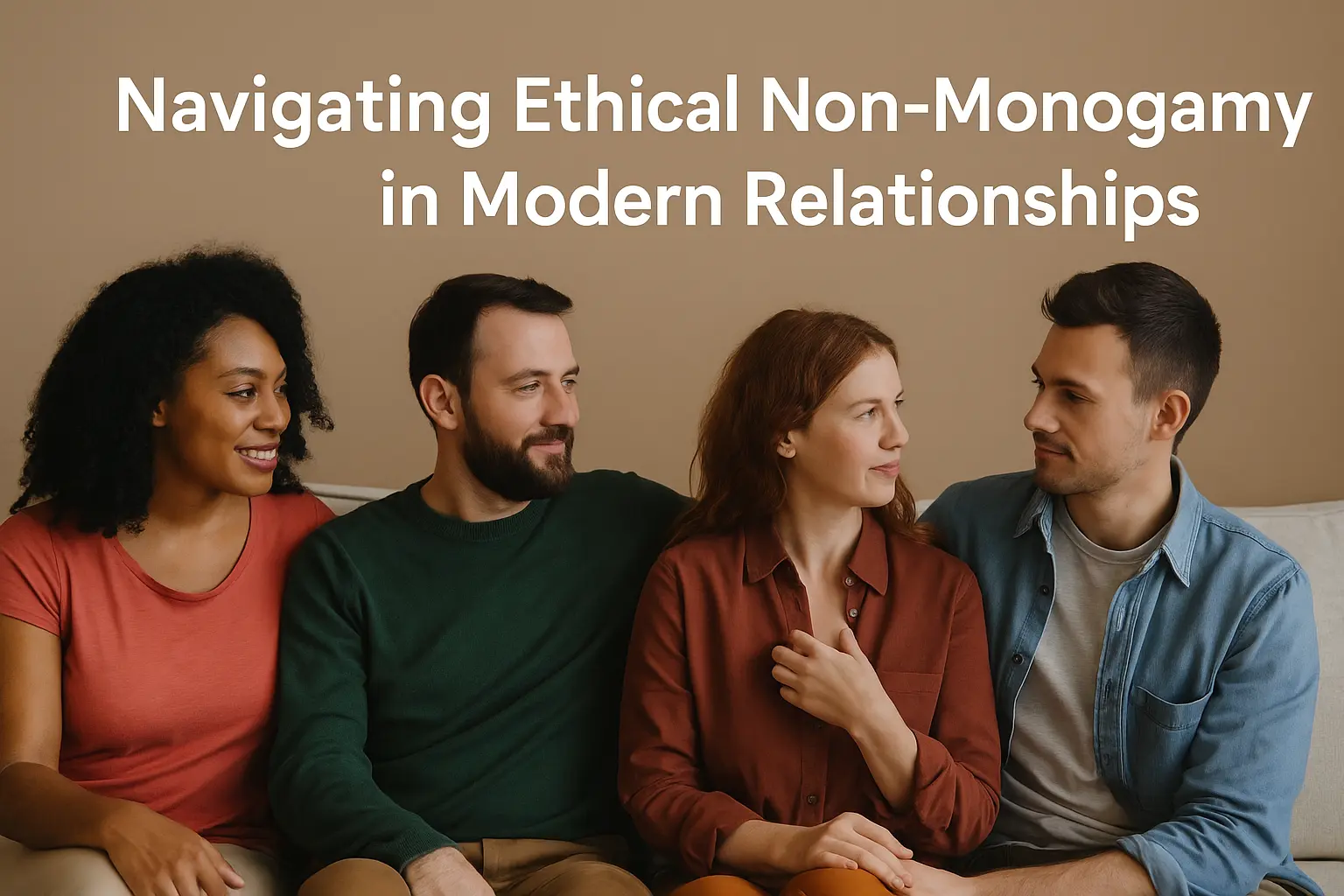Ethical non-monogamy is becoming an increasingly visible and accepted relationship model in modern society. Also known as consensual non-monogamy (CNM), it refers to relationship styles where individuals engage in more than one romantic or sexual connection with full knowledge and consent of all involved. This distinguishes it clearly from cheating, which involves secrecy or deception.
The word “ethical” from ethical non‑monogamy underscores transparency, trust, and mutual respect—values often encapsulated in the “three C’s”: communication, consideration, and consent. These principles guide couples in crafting personalized dynamics—whether open relationships, polyamory, or relationship anarchy—that honor everyone’s boundaries and desires.
Table of Content
Why More Couples Are Choosing Ethical Non-Monogamy
A Desire for Emotional & Sexual Fulfillment
Some find that no single partner can meet every need—emotional, intellectual, and physical. Ethical non‑monogamy allows exploration while maintaining a primary partnership.Questioning Mononormativity
Society often assumes monogamy is the “natural” or preferred structure. Ethical non‑monogamy challenges that norm by offering diversified connection models based on individual needs.Growing Cultural Acceptance
The idea has evolved from fringe to mainstream. Studies show about 20–33% of US adults have pursued consensual non‑monogamy at some point. Increased awareness via media, books, and apps helps normalize the practice.

Common Forms of Ethical Non-Monogamy
| Type | Description | Key Focus |
|---|---|---|
| Polyamory | Multiple romantic relationships with informed consent | Emotional depth and multiple loving bonds. |
| Open relationship | Primary couple allows non-primary sexual/romantic partners | Structured freedom with agreements |
| Swinging | Usually recreational sexual encounters among couples | Emphasis on play and mutual participation |
| Relationship anarchy | Rejects hierarchy; each bond is autonomous | Radical autonomy and negotiated values. |
Core Principles of Ethical Non-Monogamy
Consent & Transparency
Explicit consent must be ongoing and enthusiastic. It must extend beyond initial agreements to continuous check‑ins and updates.
Communication
Writing your relationship “rule book” helps clarify boundaries: What’s allowed? What’s not? How do you handle new partners or emergent feelings? Regular discussions prevent misinterpretation.
Boundaries & Agreements
These can be emotional (“no dating coworkers”), sexual (“condoms always”), logistical (“one night per week outside”), and health‑related (“regular STI testing”).
Emotional Literacy
Jealousy, NRE (New Relationship Energy), disappointment – these emotions are expected. What matters is proactive identification and collaborative strategies like reassurance, rituals, or therapy.
Health & Safety
Condoms, STI testing, and open sexual health dialogues are crucial. A commitment to each other includes caring for one another’s physical well‑being.
Ethical non-monogamy also encourages couples to explore non-traditional forms of closeness beyond penetrative sex. Learn how this growing trend is changing intimacy dynamics in our article on The Rise of Non-Penetrative Sex.
Benefits of Ethical Non-Monogamy
Personal Growth and Self‑Discovery
More partners and experiences help individuals explore who they truly are and what kind of connections they value.Expanding Support Networks
With multiple partners and friends, you build community and emotional resilience.More Authentic Love
Healthy non-monogamy rejects societal conditioning and fosters honest, self‑directed relationships.Renewed Stability in Primary Relationships
For many couples, consciously chosen openness strengthens trust and intimacy—it’s not about loss but conscious expansion.
If you and your partner are exploring ethical non-monogamy as a way to bring fresh excitement into your relationship, you might also enjoy playful ways to reconnect one-on-one. Check out our guide on the Top 5 Sex Games to Spice Up Your Relationship for fun, flirty ideas that enhance intimacy and communication.
Challenges and How to Handle Them
Jealousy & Insecurity
Normal human emotions. Strategies include acknowledging feelings, mapping triggers, self‑soothing, and using empathetic communication.
Time Management
With more relationships comes the need to balance emotional investment and scheduling. Calendar sharing, date rotation, and prioritizing self‑care are effective tools.
Social Stigma
Non‑monogamous individuals may experience judgment or isolation. Support groups, online forums, and pro‑nonmonogamy therapists can offer reassurance and solidarity.
Ethical Drift
Without ongoing monitoring, ENM can devolve into emotionally irresponsible or unethical interactions. Upholding core values and revisiting agreements regularly helps prevent drift.
Step‑by‑Step Guide for Couples
Self‑Reflection
Ask yourself: “Why am I drawn to ethical non‑monogamy?” “What do I hope to get out of it?” Journaling or discussing can clarify intentions. Before exploring ethical non-monogamy, it’s essential to understand the foundations of a healthy sexual connection. Our guide on What Is a Healthy Sexual Relationship breaks down emotional and physical elements that support long-lasting intimacy.Start the Conversation
Use a gentle tone: “This is a possible fantasy of mine…” Acknowledge your primary bond, then ask open questions.Define Intentions and Style
Explore different types and what each of you wants—emotional connection, sexual novelty, or both.Create Agreements
Draft rules covering emotional, sexual, health, and logistical aspects. Put them in writing and revisit them periodically.Take It Slow
Like marathon training, ethical non‑monogamy takes gradual pacing. Evaluate after each step and adjust as needed.Regular Check-Ins
1–2× monthly discussions: How are boundaries holding? Are emotions shifting? Is there room to expand—or pull back?Seek Support
Books like Opening Up, More Than Two, and The Ethical Slut provide guidance. Therapists experienced in polyamory can be invaluable.
Final Thoughts
Ethical non‑monogamy offers a powerful alternative to traditional monogamy—grounded in communication, consent, and honesty. It’s not a magic fix for relationship problems, but a framework that, when approached thoughtfully, can expand intimacy and personal growth. To do it well, couples must:
- Explore why they’re drawn to it
- Build clear agreements around boundaries
- Ensure emotional literacy to handle complex feelings
- Protect health and safety
- Maintain ongoing conversations
By following these steps, ethical non‑monogamy becomes a woven tapestry—crafted with respect, care, and integrity.
Ethical non-monogamy isn’t just a lifestyle—it’s a topic of active research and academic interest. In fact, researchers have even developed a tool called the Consensual Non-Monogamy Attitude Scale (CNAS) to study people’s perceptions and acceptance of non-traditional relationship models. This growing body of research highlights how important open dialogue and mutual understanding are in modern relationships.




